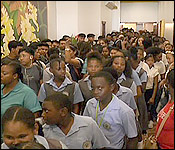
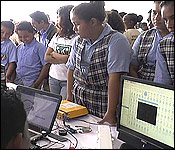 Last year in March, we showed you the tech savy high schoolers who participated in the first annual Raspberry Pi Jam. It's a competition which the Public Utilities Commission put together in partnership with the Ministry of Education to try to encourage bright young students to immerse themselves into the world of computer technology.
Last year in March, we showed you the tech savy high schoolers who participated in the first annual Raspberry Pi Jam. It's a competition which the Public Utilities Commission put together in partnership with the Ministry of Education to try to encourage bright young students to immerse themselves into the world of computer technology.
As we told you, the PUC invested a quarter million dollars to acquire Raspberry Pi computers, which they distributed to high schools all across the country for free. These miniature computers make great teaching tools, allowing students to disassemble and re-assemble them as they see fit, so that they can improvise and invent.
Well, since the students had a year of experience with the devices, the organizers of the Raspberry Pi Jam were hoping that they would show up with inspiring creations. And, the competitors did not disappoint. Our news team was there, and Daniel Ortiz has that story:
Daniel Ortiz reporting
The Princess Ramada Hotel was overrun today by hundreds of primary and high school students who were waiting for an opportunity to see what their peers from the participating schools did with the Raspberry Pi computer this time around.
Hon. Patrick Faber - DPM/ Minister of Education
 "The hallways and stairs and even the lobby is overflowing with students who are really excited to be here, and to see the potential projects that the Raspberry Pi can offer."
"The hallways and stairs and even the lobby is overflowing with students who are really excited to be here, and to see the potential projects that the Raspberry Pi can offer."
John Avery - Chairman, PUC
 "Today, we're having our second raspberry pi jam. This is all being done under the Young Innovators Program that the PUC decided to start in 2013."
"Today, we're having our second raspberry pi jam. This is all being done under the Young Innovators Program that the PUC decided to start in 2013."
"As part of our mandate to promote technology, and to inspire Belizeans to producers, as opposed to consumers, and to let us in fact, some time maybe, to change the world, we decided to embark on this."
Hon. Patrick Faber
"The schools that are participating, most of them have participated before. I'm expecting a little higher of play this year, and the competition, I'm told, is a bit stronger than last year. So, we're looking for great projects."
We certainly got an eyeful of the technological marvels that these intelligent and agile young minds could conceptualize. It was a buffet of IT crafts that the students were able to create, and they were all powered by the Raspberry Pi. And if these innovators seemed right at home with the technology, it's because they were waiting for an opportunity to explore the seemingly alien world of software and hardware integration, and computer coding.
John Avery
"You'll be surprised to know that when we started this, it appears that the students were waiting for it. As soon as we started talking about the Raspberry Pi, we were flooded with all kinds of videos of students already tinkling with the Raspberry Pi."
There was hardly any elbow room throughout the entire morning of the Raspberry Pi Jam, but we got a sample of creations that were on display.
Take this smart mirror for example. It's designed by the students from Sadie Vernon High School. The premise is to give users access to easily digestible data like news headlines, weather information, and a calendar, perfect for busy persons trying get ready in the mornings for school or work. Of course, it's powered by the Raspberry Pi.
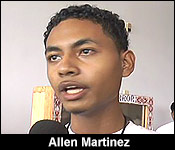 Allen Martinez - Student, Sadie Vernon High
Allen Martinez - Student, Sadie Vernon High
"The Raspberry Pi is like the brain. Without the Raspberry Pi, there is no smart mirror. The idea for the smart mirror is because, as you know, in the mornings, that morning rush, we try to eliminate that, by just having news, weather, a compliment for the day. It really makes it feel good.
"It also gives you the headline for like the world news and upcoming events."
"It's user-friendly. It's can be personalized. We have an app for either iOS or android, that you can download and control the entire smart mirror. And we also made it very easy. You don't need to know anything about programming. All you need to do is have the - we have a python script - all you need is that. Plug it in, and it works."
Then, we got a chance to look at this automated smart car, presented by the students of Nazarene High School. It that can be driven remotely, using GPS and the internet.
Josue Beltran - Nazarene High School
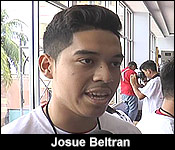 "This is an RC car, how it works is through the Raspberry Pi, we're able to connect it to the camera, and the motors of the car, which allows us to move it around and and give it direction. And how it works is because of a little device called the L298NH controller, which allows us to give it - it's basically a motherboard which allows us to give it direction to the car. And it allows us to control it through the internet."
"This is an RC car, how it works is through the Raspberry Pi, we're able to connect it to the camera, and the motors of the car, which allows us to move it around and and give it direction. And how it works is because of a little device called the L298NH controller, which allows us to give it - it's basically a motherboard which allows us to give it direction to the car. And it allows us to control it through the internet."
So, you could be anywhere from, as far as Corozal, and the car could be as close as here, but yet, through the internet, through our network, it allows us to control it. So, it doesn't matter the direction, location, or where the user is, or where the car is. As long as it's in our network, it allows us to control it."
"Nowadays, car companies are actually implementing this to safe driving software, allow it to control itself."
And from automated cars, how about automated piece of heavy machinery? That's what the teachers and students from the Providence 7-Day Adventist High School in the Toledo District put together. They even built a model that looks like it could be a contender on Robot Wars.
Josein Vasquez - Teacher, Providence SDA High
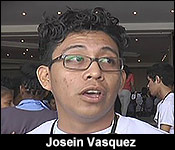 "This device is working through programming that is being done through the Raspberry Pi program, and then it could be commanded using an app. With the computer, it could literally move in different direction, depending on what angle we want it, and it can also move its arm, and close it, so that it could lift heavy objects."
"This device is working through programming that is being done through the Raspberry Pi program, and then it could be commanded using an app. With the computer, it could literally move in different direction, depending on what angle we want it, and it can also move its arm, and close it, so that it could lift heavy objects."
"We're also looking at the idea of future construction enterprises. Equipment and services could be done using technology. In the future, everything might be controlled by computer. So, even machines like this, heavy equipment, like cranes, could be used using this."
The students from the Toledo Community College made several entries into the Jam this year. They showed us their replica of an automated toll bridge. They tell us that they got the idea from seeing the inefficiencies at the Tower Hill Toll Bridge.
Exodus Tillett - Student, Toledo Community College
"When traveling, there are two sides to the road, and there is only one person in the boot, it's kind of frustrating because you want to reach your destination, but the person operating the bridge is on the other side, opening the gate. So, we decided to solve this problem by making the bridge fully automated."
 "This is an automated version of a toll bridge. How it works is that there is an ultrasonic sensor that senses the distance that car is away from the gate, and you have a special card, a smart card, that you swipe. And when that card is swiped, it is registered, and the gate automatically opens, and the car passes."
"This is an automated version of a toll bridge. How it works is that there is an ultrasonic sensor that senses the distance that car is away from the gate, and you have a special card, a smart card, that you swipe. And when that card is swiped, it is registered, and the gate automatically opens, and the car passes."
They also created a basic robotic hand, displaying knowledge not only in computer and mechanical engineering, but also of anatomy, and the way that the digits of a human hand work.
Abraham Aldana - Student, Toledo Community College
 "The hand is controlled and operated by one motor called the stepper motor. It turns strings that in turn, moves the fingers of the hand. We got this idea because just recently, we had gone to a haunted house, and it wasn't that scary, so we wanted to improve the following, in the future, we want to improve how haunted houses are made."
"The hand is controlled and operated by one motor called the stepper motor. It turns strings that in turn, moves the fingers of the hand. We got this idea because just recently, we had gone to a haunted house, and it wasn't that scary, so we wanted to improve the following, in the future, we want to improve how haunted houses are made."
"Each finger, the finger is cut by the vein. It is cut like a triangle, then it can be bent. It then has a wire which goes inside, and inside the finger, the motor will then turn, which will then cause the fingers to close"
Daniel Ortiz
"And how does the Raspberry Pi help you guys to program how the hand moves."
Abraham Aldana
"The Raspberry Pi helps us because it makes it much easier. We can do it automated, rather than pressing buttons. You can just write a program, and cause it to move by itself."
The students from the Stann Creek Ecumenical High School built an automated flood warning system. They want to better equip NEMO offices around the country.
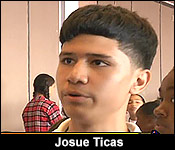 Josue Ticas - Student, Stann Creek Ecumenical High
Josue Ticas - Student, Stann Creek Ecumenical High
"We all know that we have the hurricane season from June to November, which has a lot of rain, so in 2008, we had the Tropical Storm Arthur which washed away the Kendal Bridge. And, in that occurrence, we had 7 deaths, and it happened at night. So, the people weren't aware of what was happening. So, we built this project to prevent that."
 Vance Petillo - Student, Stann Creek Ecumenical High
Vance Petillo - Student, Stann Creek Ecumenical High
"We have an ultrasonic sensor, which measures the distance from the bridge to surface of the water. As the distance between bridge and the surface of the water becomes less, that means that the water level is beginning to rise, which then triggers the blue light. That means that everybody within that area have to evacuate. As the water level continues to rise, the red light comes on, which then trigger the camera to take a picture, to verify that it's a flood. After the camera takes the picture, it then triggers an alarm, which means that anybody left within a 2-mile range have to evacuate now because the flood has reached."
And then, the data which has been collected will be sent to the NEMO office."
And though these students are able to easily explain what's happening at the technical level of their project, it's easy to forget that they are the exceptions, and not the rule.
Vanice Petillo
"It has its parts of complexity because we need to know what we're doing. We need to program the different parts of the equipment to do what we want. So, along with that, it comes with different coding, and we need to understand the coding. Along with the coding, it we write a code, and it's missing at least a full stop, the code will not run. It will not work. So, we need to know what it is doing, and we have to take our time to review the code. It takes a lot patience."
And to attract more Belizeans to the idea of they can contribute to technological advancements of the world, the PUC is rolling out the Raspberry Pi Jam to the primary school's countrywide.
John Avery
"Next year, we hope to introduce a new program that will focus on the primary schools."
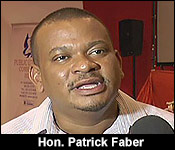 Hon. Patrick Faber
Hon. Patrick Faber
"The technology knows no age range, and so, children from very very early - 1 year-old, 2 years-old - they embrace the technology. They're born into the digital, and so, it is not that it can be that we can ever say that they're too young to engage with the technology. So, we're very excited about that possibility."
This competition is a part of the PUC's Young Innovator's Program. Deputy Prime Minister Patrick Faber publicly called for the return of the mobile apps workshop, which is also another initiative from the PUC.



